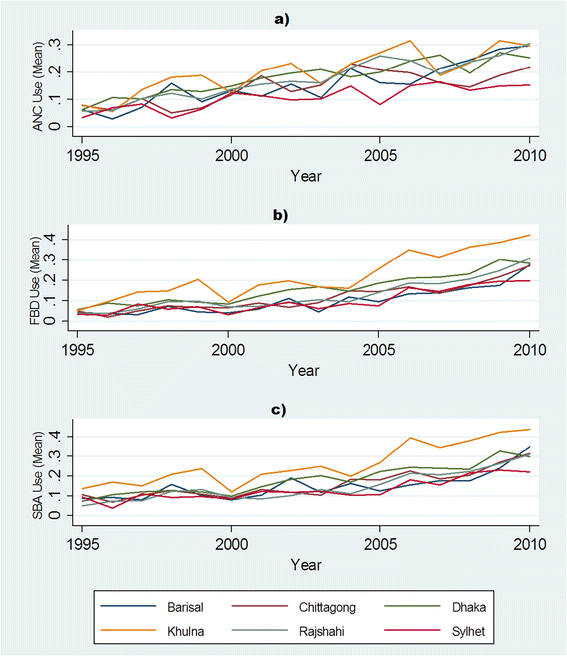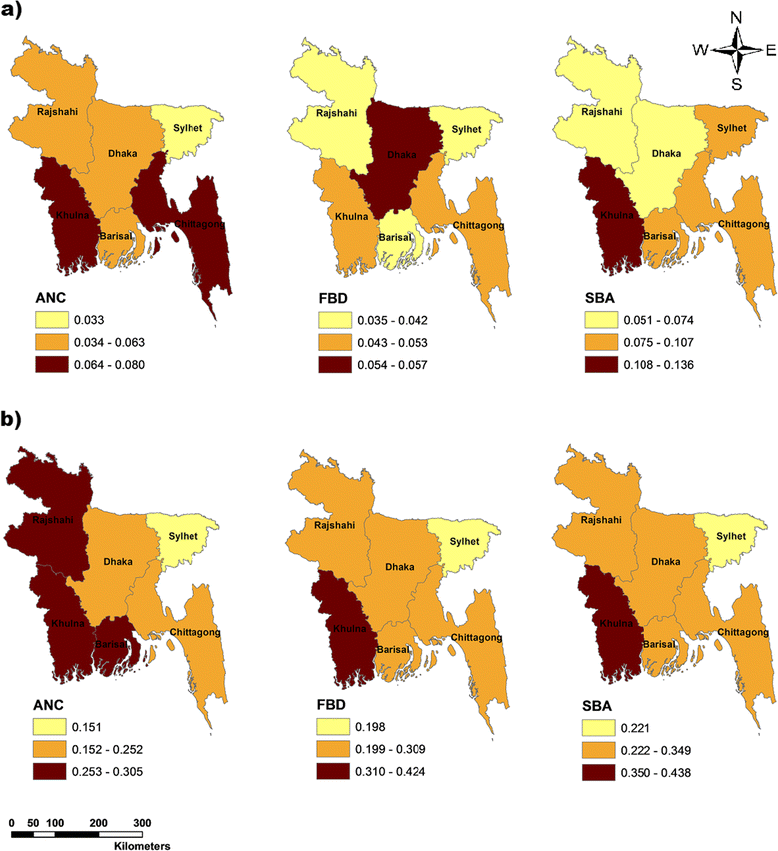Social inequalities in the utilization of maternal care in Bangladesh: Have they widened or narrowed in recent years?
- PMID: 25492512
- PMCID: PMC4272805
- DOI: 10.1186/s12939-014-0120-4
Social inequalities in the utilization of maternal care in Bangladesh: Have they widened or narrowed in recent years?
Abstract
Background: Notwithstanding the significant progress in reducing maternal mortality in recent years, social inequalities in the utilization of maternal care continue to be a challenge in Bangladesh. In this study, we aim to provide a comprehensive analysis of trends in social inequalities in utilization of antenatal care (ANC), facility based delivery (FBD), and skilled birth attendance (SBA) in Bangladesh between 1995 and 2010.
Methods: Data were extracted from the five latest rounds of Bangladesh Demographic Health Surveys (BDHS). The Theil index (T) and between-group variance (BGV) were used to calculate relative and absolute disparities in the utilization of three measures (ANC, FBD, and SBA) of maternal care across six administrative regions. The relative and slope indices of inequality (RII and SII, respectively) were also used to calculate wealth- and education-based inequality in the utilization of maternal care.
Results: The results of the T-index suggest that relative inequality in SBA has declined by 0.2% per year. Nevertheless, the estimated BGV demonstrated that absolute inequalities in all three measures of maternal care have increased across administrative divisions. For all three measures of maternal care, the RII and SII indicated consistent socioeconomic inequalities favouring wealthier and more educated women. The adjusted RII suggested that wealth- and education-related inequalities for ANC declined by 9% and 6%, respectively, per year during the study period. The adjusted SII, however, showed that wealth- and education-related inequalities for FBD increased by 0.6% per year.
Conclusions: Although socially disadvantaged mothers increased their utilization of care relative to mothers of higher socioeconomic status, the absolute gap in utilization of care between socioeconomic groups has increased over time. Our findings indicate that wealthier and more educated women, as well as those living in urban areas, are the major users of ANC, FBD and SBA in Bangladesh. Thus, priority focus should be given to implementing and evaluating interventions that benefit women who are poorer, less educated and live in rural areas.
Figures


Similar articles
-
Geographical and socioeconomic inequalities in the utilization of maternal healthcare services in Nigeria: 2003-2017.BMC Health Serv Res. 2020 Sep 10;20(1):849. doi: 10.1186/s12913-020-05700-w. BMC Health Serv Res. 2020. PMID: 32912213 Free PMC article.
-
Comparison of inequality in utilization of maternal healthcare services between Bangladesh and Pakistan: evidence from the demographic health survey 2017-2018.Reprod Health. 2023 Mar 13;20(1):43. doi: 10.1186/s12978-023-01595-y. Reprod Health. 2023. PMID: 36915151 Free PMC article.
-
Inequalities in maternal health care utilization in sub-Saharan African countries: a multiyear and multi-country analysis.PLoS One. 2015 Apr 8;10(4):e0120922. doi: 10.1371/journal.pone.0120922. eCollection 2015. PLoS One. 2015. PMID: 25853423 Free PMC article.
-
Inequity in uptake of maternal health care services in developing countries: a systematic review and meta-analysis.Front Public Health. 2024 Jun 26;12:1415092. doi: 10.3389/fpubh.2024.1415092. eCollection 2024. Front Public Health. 2024. PMID: 38989116 Free PMC article.
-
Inequities in utilization of reproductive and maternal health services in Ethiopia.Int J Equity Health. 2017 Jun 19;16(1):105. doi: 10.1186/s12939-017-0602-2. Int J Equity Health. 2017. PMID: 28629358 Free PMC article. Review.
Cited by
-
Geographical and socioeconomic inequalities in the utilization of maternal healthcare services in Nigeria: 2003-2017.BMC Health Serv Res. 2020 Sep 10;20(1):849. doi: 10.1186/s12913-020-05700-w. BMC Health Serv Res. 2020. PMID: 32912213 Free PMC article.
-
Factors Associated with Post-Natal Care Utilization among the Women of Reproductive age Group: Evidence from Bangladesh Demographic and Health Survey 2017-18.Health Serv Res Manag Epidemiol. 2022 Nov 7;9:23333928221136393. doi: 10.1177/23333928221136393. eCollection 2022 Jan-Dec. Health Serv Res Manag Epidemiol. 2022. PMID: 36388173 Free PMC article.
-
Inequities in maternal health services utilization in Ethiopia 2000-2016: magnitude, trends, and determinants.Reprod Health. 2018 Jul 4;15(1):119. doi: 10.1186/s12978-018-0556-x. Reprod Health. 2018. PMID: 29973244 Free PMC article.
-
Comparison of inequality in utilization of maternal healthcare services between Bangladesh and Pakistan: evidence from the demographic health survey 2017-2018.Reprod Health. 2023 Mar 13;20(1):43. doi: 10.1186/s12978-023-01595-y. Reprod Health. 2023. PMID: 36915151 Free PMC article.
-
Trends in inequalities in utilization of reproductive health services from 2000 to 2011 in Vietnam.J Rural Med. 2015;10(2):65-78. doi: 10.2185/jrm.2902. Epub 2015 Dec 23. J Rural Med. 2015. PMID: 26705431 Free PMC article.
References
-
- Lozano R, Wang H, Foreman KJ, Rajaratnam JK, Naghavi M, Marcus JR, Dwyer-Lindgren L, Lofgren KT, Phillips D, Atkinson C, Lopez AD, Murray CJL. Progress towards Millennium Development Goals 4 and 5 on maternal and child mortality: an updated systematic analysis. Lancet. 2011;378:1139–1165. doi: 10.1016/S0140-6736(11)61337-8. - DOI - PubMed
-
- WHO, UNICEF, UNFPA. Bank W. Trends in Maternal Mortality: 1990 to 2010. Geneva, Switzerland: World Health Organization; 2012.
Publication types
MeSH terms
Grants and funding
LinkOut - more resources
Full Text Sources
Other Literature Sources
Medical
Miscellaneous

